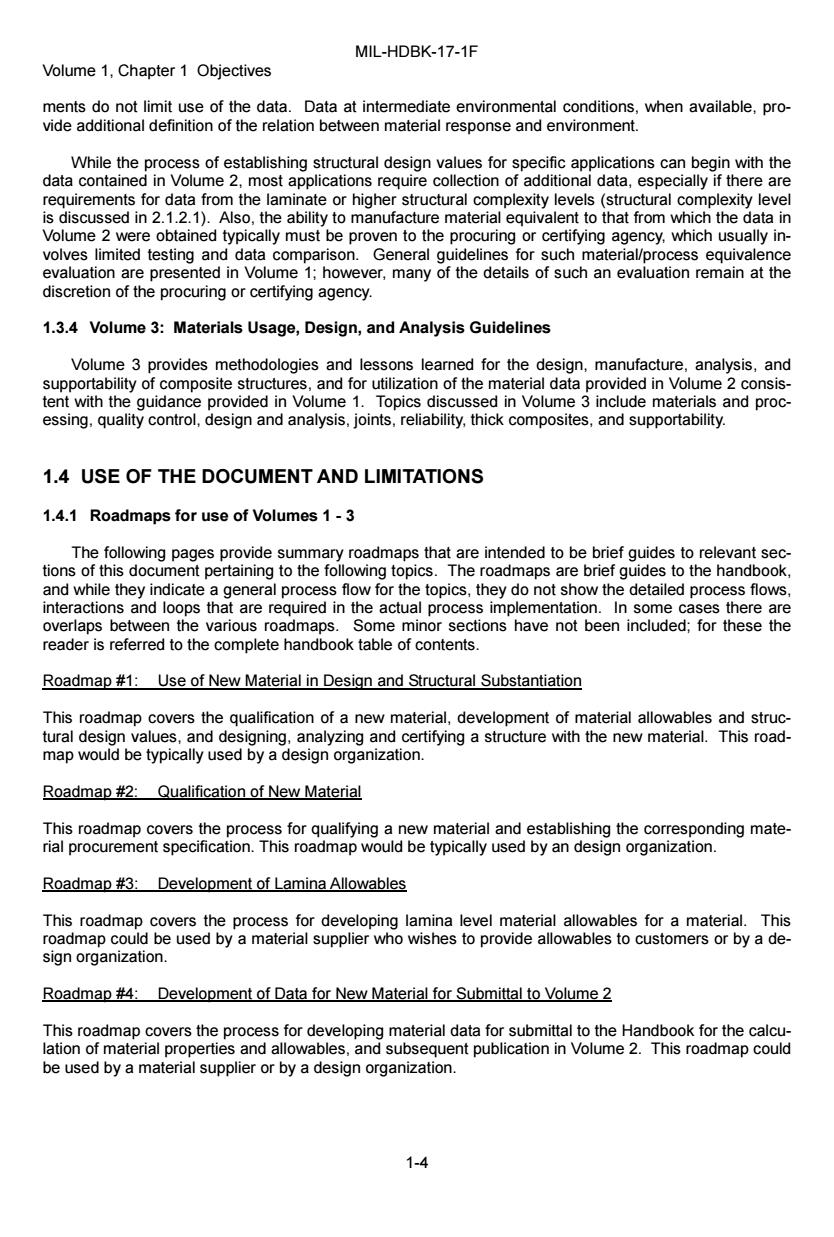正在加载图片...

MIL-HDBK-17-1F Volume 1,Chapter 1 Objectives ments do not limit use of the data.Data at intermediate environmental conditions,when available,pro- vide additional definition of the relation between material response and environment. While the process of establishing structural design values for specific applications can begin with the data contained in Volume 2,most applications require collection of additional data,especially if there are requirements for data from the laminate or higher structural complexity levels (structural complexity level is discussed in 2.1.2.1).Also,the ability to manufacture material equivalent to that from which the data in Volume 2 were obtained typically must be proven to the procuring or certifying agency,which usually in- volves limited testing and data comparison.General guidelines for such material/process equivalence evaluation are presented in Volume 1:however,many of the details of such an evaluation remain at the discretion of the procuring or certifying agency. 1.3.4 Volume 3:Materials Usage,Design,and Analysis Guidelines Volume 3 provides methodologies and lessons learned for the design,manufacture,analysis,and supportability of composite structures,and for utilization of the material data provided in Volume 2 consis- tent with the guidance provided in Volume 1.Topics discussed in Volume 3 include materials and proc- essing,quality control,design and analysis,joints,reliability,thick composites,and supportability. 1.4 USE OF THE DOCUMENT AND LIMITATIONS 1.4.1 Roadmaps for use of Volumes 1-3 The following pages provide summary roadmaps that are intended to be brief guides to relevant sec- tions of this document pertaining to the following topics.The roadmaps are brief guides to the handbook, and while they indicate a general process flow for the topics,they do not show the detailed process flows. interactions and loops that are required in the actual process implementation.In some cases there are overlaps between the various roadmaps.Some minor sections have not been included;for these the reader is referred to the complete handbook table of contents. Roadmap #1:Use of New Material in Design and Structural Substantiation This roadmap covers the qualification of a new material,development of material allowables and struc- tural design values,and designing,analyzing and certifying a structure with the new material.This road- map would be typically used by a design organization. Roadmap #2:Qualification of New Material This roadmap covers the process for qualifying a new material and establishing the corresponding mate- rial procurement specification.This roadmap would be typically used by an design organization. Roadmap #3:Development of Lamina Allowables This roadmap covers the process for developing lamina level material allowables for a material.This roadmap could be used by a material supplier who wishes to provide allowables to customers or by a de- sign organization. Roadmap #4:Development of Data for New Material for Submittal to Volume 2 This roadmap covers the process for developing material data for submittal to the Handbook for the calcu- lation of material properties and allowables,and subsequent publication in Volume 2.This roadmap could be used by a material supplier or by a design organization. 1-4MIL-HDBK-17-1F Volume 1, Chapter 1 Objectives 1-4 ments do not limit use of the data. Data at intermediate environmental conditions, when available, provide additional definition of the relation between material response and environment. While the process of establishing structural design values for specific applications can begin with the data contained in Volume 2, most applications require collection of additional data, especially if there are requirements for data from the laminate or higher structural complexity levels (structural complexity level is discussed in 2.1.2.1). Also, the ability to manufacture material equivalent to that from which the data in Volume 2 were obtained typically must be proven to the procuring or certifying agency, which usually involves limited testing and data comparison. General guidelines for such material/process equivalence evaluation are presented in Volume 1; however, many of the details of such an evaluation remain at the discretion of the procuring or certifying agency. 1.3.4 Volume 3: Materials Usage, Design, and Analysis Guidelines Volume 3 provides methodologies and lessons learned for the design, manufacture, analysis, and supportability of composite structures, and for utilization of the material data provided in Volume 2 consistent with the guidance provided in Volume 1. Topics discussed in Volume 3 include materials and processing, quality control, design and analysis, joints, reliability, thick composites, and supportability. 1.4 USE OF THE DOCUMENT AND LIMITATIONS 1.4.1 Roadmaps for use of Volumes 1 - 3 The following pages provide summary roadmaps that are intended to be brief guides to relevant sections of this document pertaining to the following topics. The roadmaps are brief guides to the handbook, and while they indicate a general process flow for the topics, they do not show the detailed process flows, interactions and loops that are required in the actual process implementation. In some cases there are overlaps between the various roadmaps. Some minor sections have not been included; for these the reader is referred to the complete handbook table of contents. Roadmap #1: Use of New Material in Design and Structural Substantiation This roadmap covers the qualification of a new material, development of material allowables and structural design values, and designing, analyzing and certifying a structure with the new material. This roadmap would be typically used by a design organization. Roadmap #2: Qualification of New Material This roadmap covers the process for qualifying a new material and establishing the corresponding material procurement specification. This roadmap would be typically used by an design organization. Roadmap #3: Development of Lamina Allowables This roadmap covers the process for developing lamina level material allowables for a material. This roadmap could be used by a material supplier who wishes to provide allowables to customers or by a design organization. Roadmap #4: Development of Data for New Material for Submittal to Volume 2 This roadmap covers the process for developing material data for submittal to the Handbook for the calculation of material properties and allowables, and subsequent publication in Volume 2. This roadmap could be used by a material supplier or by a design organization